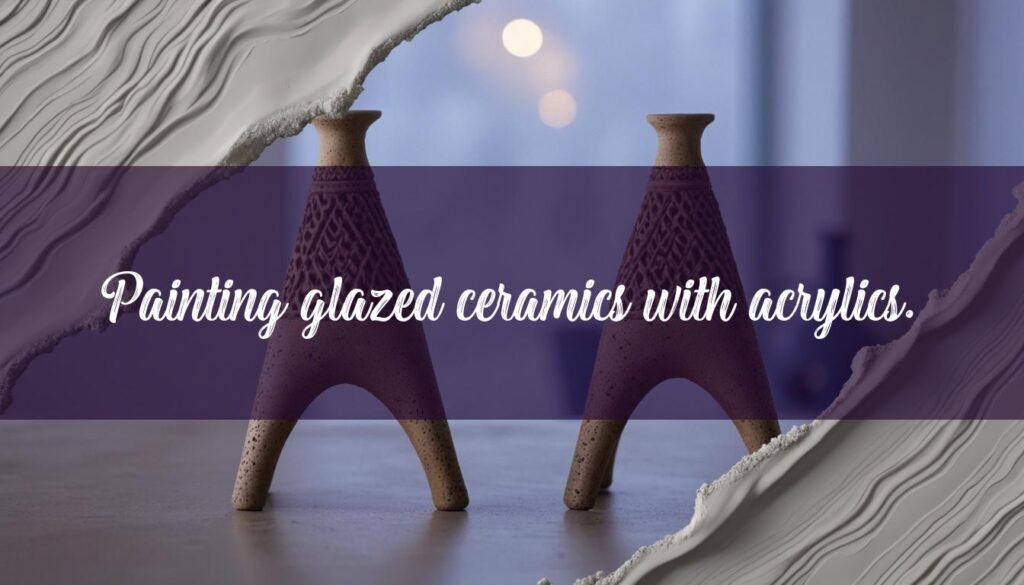Painting already glazed ceramics can be a fun and creative way to breathe new life into old pieces or personalize store-bought items. However, because of the slick surface, it’s important to approach the project with the right techniques and materials to ensure your designs last. This article will guide you through the process, from prepping your ceramic piece to applying paint and sealing your artwork for durability. You can find ceramics to paint at many local shops, or explore options for buying ceramics to paint online.
Preparing Your Glazed Ceramic Surface
Before you even think about picking up a paintbrush, proper preparation is key to ensuring the paint adheres well to the glazed surface. Glazed ceramics are notoriously smooth, which can make it difficult for paint to stick. Start by thoroughly cleaning the ceramic item with soap and water to remove any dirt, dust, or oils. After washing, give the piece a final wipe down with an alcohol wipe to eliminate any lingering residues.
Next, lightly sand the glazed surface with fine-grit sandpaper. The goal here isn’t to remove the glaze entirely, but to create a slightly rougher texture that the paint can grip onto. After sanding, it’s crucial to remove all sanding dust with a clean, damp cloth. Some artists also recommend applying a primer specifically designed for ceramics. Primers help the paint adhere better and can significantly extend the life of your painted design. By taking the time to properly prepare the surface, you’re setting yourself up for success and ensuring that your painted design will last.
Choosing the Right Type of Paint
Selecting the correct type of paint is crucial for a successful and lasting finish on glazed ceramics. While various paints can be used, some are better suited than others due to their adhesive properties and durability. Acrylic paints are a popular choice because they are readily available, come in a wide range of colors, and are relatively easy to work with. For glazed ceramics, it’s advisable to use high-quality acrylic paints that are specifically formulated for glass or ceramics, like DecoArt Glass Paint, as these offer better adhesion. These paints often have a thicker consistency, providing better coverage with fewer coats.
Enamel paints are another option, known for their glossy finish and durability. They are particularly suitable for items that will be handled frequently or exposed to the elements. However, enamel paints can have a strong odor and may require longer drying times. Specialized ceramic paints, which can be found at art supply stores, are designed specifically for use on ceramics and offer excellent adhesion and vibrant colors. Another option is translucent or opaque glaze water-based colors which are used to create decorative finishes. Ultimately, the best paint for your project will depend on your desired finish, the intended use of the ceramic piece, and your personal preferences.
This video from Ceramic Materials Workshop provides a great overview of using UMF in glaze chemistry. Understanding UMF is key to successful glaze application.
Painting Techniques and Application
Once your surface is prepped and your paint is chosen, it’s time for the fun part: painting! Start by applying thin, even coats of paint. Avoid applying too much paint at once, as this can lead to drips and uneven coverage. Allow each coat to dry completely before applying the next. Depending on the paint you’re using, you may need to apply multiple coats to achieve full opacity. For intricate designs, consider using fine-tipped brushes to achieve precise lines and details. If you’re working on a larger area, larger flat brushes are great for larger pieces, and small, round-tip brushes are better for patterns or designs.
To avoid brush strokes, try to maintain a consistent brush direction and avoid going over the same area repeatedly while the paint is drying. If you want to try something unique, you can explore stippling, sponging, or glaze trailing techniques to add texture and visual interest to your design. For example, using a slip trailer, which is a small squeezable bottle with an aperture tip, to create patterns. Remember, patience is key! Taking your time and allowing each layer to dry properly will result in a smoother, more professional-looking finish.
Sealing and Curing for Durability
After you’ve finished painting your design, sealing and curing are essential steps to protect your work and ensure its longevity. Sealing the paint not only prevents chipping and fading but also makes your ceramic piece suitable for practical use. There are several options for sealants, each with its own pros and cons. Ceramic glaze can be applied for a glossy finish and added durability, but this usually requires firing the piece in a kiln. For a less involved method, you can use a water-based polyurethane varnish, clear acrylic coat, or Mod Podge.
When applying a sealant, work in a well-ventilated area and use even strokes to cover the entire painted surface. Follow the manufacturer’s instructions for drying times, as some sealants may require several hours or even days to fully cure. Some sealants may require baking in an oven to cure, so be sure to read the instructions carefully. While sealing can protect your design, it’s important to note that not all sealants are food-safe or dishwasher-safe. If you intend to use your painted ceramic for dining, be sure to choose a sealant that is specifically labeled as food-safe and follow the manufacturer’s recommendations for use and care. For more information, explore this guide on the best paint to use on ceramic.





